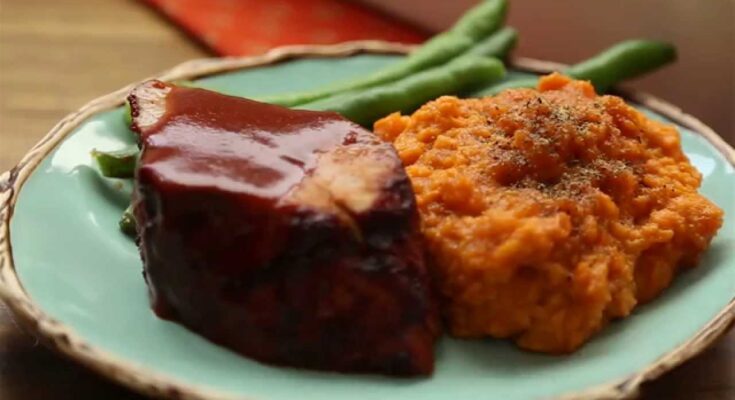Mashed Sweet Potatoes Recipe: Mashed sweet potatoes are the ultimate comfort food that combines simplicity, flavor, and nutrition. Whether you’re cooking for a holiday feast or just whipping up a quick side dish on a weeknight, they never disappoint. Unlike regular mashed potatoes, sweet potatoes bring a natural sweetness and vibrant color that make them a standout on any plate. They’re like that cozy sweater you reach for in the fall—warm, satisfying, and always hits the spot.
These orange wonders are not only delicious but also super versatile. You can go sweet or savory, creamy or chunky, rustic or gourmet—it all depends on your mood. That’s the beauty of mashed sweet potatoes: they adapt. Want to throw in some maple syrup and cinnamon? Go for it. Prefer garlic and thyme? That works too. They’re the blank canvas of side dishes.
Plus, they’re a total hit with both adults and kids, and if you’re trying to sneak in a healthier option without sacrificing taste, this dish is your best bet.
Sweet Potatoes vs Regular Potatoes
Sweet potatoes and regular white potatoes might look similar at first glance, but they’re nutritionally and flavor-wise worlds apart. First off, sweet potatoes have a naturally rich, earthy sweetness, making them an ideal base for both savory and dessert-style dishes. They also contain more fiber, vitamin A (thanks to all that beta-carotene), and are lower on the glycemic index, which means they won’t spike your blood sugar as dramatically.
Regular potatoes, while great for fluffy mashed potatoes, tend to be more starchy and neutral in flavor. That neutrality can be a plus for some dishes, but if you’re looking for something with built-in character, sweet potatoes win every time. Plus, that gorgeous orange hue isn’t just pretty—it’s a sign of their antioxidant power.
In a head-to-head taste test, sweet potatoes bring a richer depth of flavor, especially when mashed. They’re naturally creamy and need less butter or cream to reach that perfect texture. If you’re ready to elevate your mashed potato game, switching to sweet potatoes might just be the smartest (and tastiest) move you’ll make.
Ingredients Needed
Basic Ingredients for Classic Mashed Sweet Potatoes
Before we dive into the cooking process, let’s talk about the essentials. The beauty of mashed sweet potatoes is that you don’t need a long grocery list. Most of these ingredients are likely already in your kitchen:
- 4–5 medium sweet potatoes (about 2–3 lbs)
- 4 tablespoons of unsalted butter
- 1/2 cup of milk (whole milk or your preferred alternative)
- Salt to taste
- Pepper (optional, but adds depth)
These basics are your starting point. They create a smooth, buttery mash that lets the sweet potato flavor shine. Butter adds richness, milk smooths everything out, and salt balances the sweetness.
Want to make it vegan? No problem. Swap in plant-based butter and a splash of almond, oat, or soy milk. It’s just as creamy, and still full of flavor.
Optional Add-ons for Extra Flavor
Now, if you’re the kind of cook who loves to add a little flair, this is where things get exciting. Here are a few popular (and delicious) mix-ins:
- 1 tablespoon of maple syrup or honey (for a sweet twist)
- A pinch of cinnamon or nutmeg
- 1–2 cloves of roasted garlic
- 2 tablespoons of sour cream or cream cheese (for extra tang and richness)
- Fresh herbs like thyme or rosemary
- Crushed red pepper flakes (for a bit of heat)
- Grated parmesan cheese (for a savory kick)
These ingredients let you tailor the mashed sweet potatoes to your mood or meal. Sweet and spiced for the holidays? Add syrup and cinnamon. Need something savory and sophisticated? Try roasted garlic and rosemary. This dish is all about flexibility.
Equipment You’ll Need
Kitchen Tools for Easy Preparation
Let’s keep it real: nobody likes doing the dishes, and the good news is mashed sweet potatoes don’t require a bunch of fancy gadgets. Here’s what you’ll need to make your life easier:
- A large pot (for boiling the sweet potatoes)
- A colander (for draining)
- A potato masher or hand mixer (depending on how smooth you like your mash)
- A vegetable peeler (makes peeling quick and easy)
- A large mixing bowl
- Wooden spoon or spatula
Optional tools that make the process even smoother:
- Immersion blender (for ultra-creamy mash)
- Food processor (only if you’re making a large batch)
A basic masher works perfectly for a rustic, textured mash, while a hand mixer gives you that silky, whipped finish. Just be careful not to overmix or you’ll end up with a gummy texture. And if you’re making this dish with kids, let them mash away—it’s fun and gets them involved in cooking.
Step-by-Step Guide to Making Mashed Sweet Potatoes
Step 1: Selecting and Washing Sweet Potatoes
The first step to a successful dish is starting with quality ingredients. When picking sweet potatoes, go for ones that are firm, smooth, and free from any blemishes or soft spots. Medium-sized potatoes are easier to handle and cook more evenly.
Once you’re home, give them a good rinse. Sweet potatoes grow underground, so they often come with a bit of dirt still clinging to the skin. Use a scrub brush under cold running water to clean them thoroughly. Even if you plan on peeling them, it’s a good idea to wash them first so dirt doesn’t get onto your cutting board or hands.
If you’re in a rush, you can microwave the sweet potatoes to soften them before peeling, but for the best flavor and texture, boiling is the way to go. It’s gentle, easy, and preserves that earthy sweetness we all love.
Step 2: Peeling and Chopping
Once your sweet potatoes are nice and clean, it’s time to peel. Use a sharp vegetable peeler and work your way around each potato. Sweet potato skins are thicker than regular ones, so don’t be shy about putting a little muscle into it. If you’re feeling adventurous, you can leave the skin on for added fiber and a rustic texture—but for that classic creamy mash, peeling is the way to go.
After peeling, chop the sweet potatoes into evenly sized chunks, about 1 to 2 inches thick. This ensures they cook evenly and quickly. If your pieces are too large, you’ll end up with some undercooked chunks. Too small, and they might turn to mush before you’re ready to mash.
Pro tip: Chop one potato at a time and keep the rest whole to prevent them from drying out or browning too fast. If you’re prepping in advance, soak the chopped pieces in cold water to keep them fresh while you work.
Step 3: Boiling the Sweet Potatoes
Now that your potatoes are peeled and chopped, toss them into a large pot. Cover the pieces with cold water—about an inch above the top of the potatoes—and add a generous pinch of salt. Starting with cold water helps the sweet potatoes cook more evenly, and the salt starts seasoning them from the inside out.
Turn the heat to high and bring the pot to a boil. Once it’s bubbling, reduce the heat to medium and let them simmer for about 15 to 20 minutes. How do you know they’re done? Stick a fork in one—if it slides in easily and the potato starts to fall apart, you’re good to go.
Avoid overboiling, though. If you let them cook too long, they’ll absorb too much water and your mash might turn runny. Keep an eye on them after the 15-minute mark, especially if your chunks are on the smaller side.
Once they’re tender, drain them in a colander and give them a few minutes to release steam. Letting them sit helps get rid of excess moisture, which means a thicker, creamier mash later on.
Step 4: Draining and Mashing
After boiling, it’s time to bring your sweet potatoes to life. Drain them thoroughly, and if you want to go the extra mile, return them to the hot pot and let them sit over low heat for 1–2 minutes to evaporate any leftover moisture.
Now, grab your potato masher or hand mixer and get to work. Start mashing while the potatoes are still hot—it makes them easier to break down and helps incorporate the butter more smoothly. Add in the butter first so it melts into the warm mash and infuses every bite with richness.
Next, slowly pour in the milk, mixing a little at a time until you reach your desired texture. Want them fluffy? Use more milk and a mixer. Prefer them chunky and rustic? Go easy on the liquid and stick to the masher.
Season with salt and pepper to taste. Don’t be afraid to taste as you go—everyone’s palate is different, and the beauty of homemade mashed sweet potatoes is that you can make them exactly the way you like.
Step 5: Mixing in Flavors and Seasonings
Here’s where you can really get creative. The base mash is already delicious, but adding a few extra ingredients can take it to the next level. Start with the classics—maple syrup for sweetness, a touch of cinnamon for warmth, or roasted garlic for a savory edge.
Want to balance the sweetness? Add a splash of sour cream or a spoonful of Greek yogurt. Need more richness? Cream cheese is your best friend. You can even stir in shredded cheese for a melty, gooey twist.
Here are a few combos to try:
- Sweet version: Maple syrup + cinnamon + nutmeg
- Savory version: Garlic + thyme + black pepper
- Tangy version: Sour cream + chives + a pinch of smoked paprika
- Gourmet version: Goat cheese + rosemary + a drizzle of olive oil
Mix everything until fully combined, then give it one final taste. Adjust your seasoning as needed, then you’re ready to serve!
Pro Tips for Perfect Mashed Sweet Potatoes
Texture, Taste, and Timing
Mastering mashed sweet potatoes isn’t rocket science, but a few pro tips can really take them from good to amazing. First, let’s talk texture. If you like them creamy and silky, a hand mixer or immersion blender is your best tool. Just be cautious not to overmix—sweet potatoes can become gluey if you whip them too much. For a chunkier, more rustic feel, use a traditional potato masher and leave a few small lumps for texture.
Next up: taste. Sweet potatoes already have a naturally rich, sweet flavor, but they can sometimes lean too far into the sweet territory if you’re not careful with add-ins. That’s why it’s important to balance the sweetness with savory elements like garlic, pepper, or herbs. Always taste as you go and adjust accordingly—more salt, a splash of acid like lemon juice, or even a dash of cayenne can make a huge difference.
Finally, let’s talk timing. Make sure you serve mashed sweet potatoes while they’re still warm. They tend to thicken as they sit, so if you’re prepping in advance, reheat them gently on the stove or in the microwave with a splash of milk to bring back the creaminess.
And here’s one bonus tip: for a slightly caramelized depth of flavor, try roasting the sweet potatoes instead of boiling. Just chop them, toss with oil, and roast until tender. Then mash as usual. It adds an entirely new layer of flavor that’s totally worth the extra time.
Variations to Try
Savory Mashed Sweet Potatoes
If you’re not into sweet-on-sweet dishes, you’ll love the savory version of mashed sweet potatoes. Think of it like mashed potatoes’ sophisticated cousin. Start with your base mash—boiled sweet potatoes, butter, and a touch of milk—and then layer in the savory goodness.
Roasted garlic is a must—it brings out a rich, nutty flavor that blends beautifully with the sweetness of the potatoes. Fresh herbs like thyme, sage, or rosemary take it to the next level. Want even more depth? Add a splash of vegetable or chicken broth instead of milk, and finish with a sprinkle of grated parmesan cheese for a umami punch.
This version pairs perfectly with roasted meats, grilled veggies, or even a hearty stew. It’s especially great for Thanksgiving or Sunday dinners when you want to impress your guests with something a little unexpected.
Sweet and Spicy Twist
Want to add some zing to your mashed sweet potatoes? Go for a sweet and spicy twist. Start with the classic base, then add in a teaspoon of cayenne pepper or chipotle powder for some heat. Balance it out with a tablespoon of brown sugar or maple syrup. The contrast of flavors—warm, spicy, sweet—is irresistible.
You can also add a pinch of smoked paprika for a smoky undertone or stir in some chopped jalapeños if you’re feeling bold. This version is a fantastic side dish for BBQ, tacos, or anything with a Southern flair.
For a festive touch, top it off with candied pecans or toasted pumpkin seeds. It adds a delightful crunch and turns a simple side dish into something memorable.
Serving Suggestions
Perfect Pairings for Any Meal
Mashed sweet potatoes are incredibly versatile, which makes them perfect for just about any meal. Here are some of the best ways to serve them:
- Holiday Feasts: Serve alongside roasted turkey, ham, or prime rib. They complement rich meats beautifully and add a pop of color to the plate.
- Weeknight Dinners: Pair with grilled chicken, seared pork chops, or even a veggie stir-fry for a healthy and hearty dinner.
- BBQ and Southern Dishes: Sweet potatoes are a natural match for ribs, pulled pork, or fried chicken. The sweetness balances out the smoky, savory flavors.
- Meatless Meals: Add a dollop of mashed sweet potatoes to a grain bowl, stuff them into a roasted pepper, or use them as a topping for a shepherd’s pie made with lentils and veggies.
Want to get fancy? Serve them in individual ramekins or piping them into swirls using a pastry bag. A sprinkle of fresh herbs or a drizzle of browned butter right before serving also adds a professional touch.
How to Store and Reheat
Storage Tips
Made too much? No worries. Mashed sweet potatoes store beautifully. Let them cool completely before transferring to an airtight container. They’ll stay fresh in the fridge for up to 4 days. If you want to keep them longer, pop them into a freezer-safe container or zip-top bag and freeze for up to 3 months.
Before freezing, flatten the mixture in the bag so it freezes evenly and is easier to thaw. Label your container with the date so you don’t forget what it is (or how long it’s been hiding in your freezer).
Reheating Without Losing Flavor
To reheat, gently warm the mashed sweet potatoes in a saucepan over low heat. Add a splash of milk or broth to bring back the creamy texture and stir frequently to avoid sticking. You can also reheat them in the microwave—just use short intervals (30–60 seconds at a time), stirring in between, until warmed through.
If the texture gets a bit thick, add a pat of butter or a spoonful of sour cream to revive the richness. You can even throw in a dash of spice or a sprinkle of herbs to freshen up the flavor.
Mashed sweet potatoes are one of those dishes that taste just as good—if not better—the next day. They’re perfect for meal prep or holiday leftovers, making your cooking life just a little bit easier.
Health Benefits of Sweet Potatoes
Nutrition Breakdown
Sweet potatoes are more than just delicious—they’re a nutritional powerhouse. Loaded with essential vitamins and minerals, they’re one of the healthiest root vegetables you can put on your plate. First off, they’re packed with vitamin A in the form of beta-carotene, which is great for your eyesight, immune system, and skin health. Just one medium sweet potato provides over 400% of your daily vitamin A needs!
They’re also rich in vitamin C, potassium, vitamin B6, and manganese, making them an excellent choice for boosting your overall health. Plus, they’re high in dietary fiber, which supports digestion and helps keep you full longer—perfect if you’re watching your weight.
Another major benefit? Sweet potatoes have a lower glycemic index than regular potatoes. This means they have a gentler effect on your blood sugar levels, making them a better option for people with diabetes or those trying to manage energy crashes after meals.
Let’s not forget the antioxidants. The rich orange color isn’t just pretty—it’s a sign of all those beneficial compounds that help fight inflammation and reduce the risk of chronic diseases.
So, mashed sweet potatoes aren’t just tasty—they’re doing some serious good for your body behind the scenes. Comfort food that’s actually good for you? That’s a win-win.
Common Mistakes to Avoid
Overcooking, Under-seasoning, and More
Even though mashed sweet potatoes are simple to make, there are a few common mistakes that can turn your dreamy side dish into a bit of a mess. Let’s break them down so you can avoid them:
- Overcooking the sweet potatoes – Boiling them too long can make them waterlogged and mushy. Once they’re fork-tender, take them off the heat and drain immediately.
- Not draining well – Excess water is the enemy of creamy mashed potatoes. After boiling, let them sit in the colander or return them to the hot pot to steam off extra moisture.
- Using too much liquid – It’s tempting to pour in all your milk or broth at once, but this can quickly make the mash too thin. Always add it gradually and adjust as needed.
- Skipping the taste test – This one’s huge. Always taste and adjust your seasonings before serving. What might seem like enough salt or spice in the bowl might need just a pinch more to really shine.
- Overmixing – Whipping sweet potatoes too much can make them gummy due to their natural starches. Stick to gentle mixing and stop once you’ve hit that smooth, creamy consistency.
- Not seasoning the boiling water – Just like with pasta, seasoning the water while the sweet potatoes boil makes a big difference. It’s your first chance to layer in flavor.
Avoid these pitfalls, and you’re guaranteed a bowl of mashed sweet potatoes that’s smooth, flavorful, and crowd-pleasing every time.
FAQs about Mashed Sweet Potatoes Recipe
What ingredients do I need for mashed sweet potatoes?
To make delicious mashed sweet potatoes, you will need sweet potatoes, butter, milk or cream, salt, and pepper. Optional additions include cinnamon, nutmeg, or maple syrup for a touch of sweetness.
How long does it take to cook mashed sweet potatoes?
The total cooking time for mashed sweet potatoes is typically about 30 minutes. This includes about 20 minutes of boiling the sweet potatoes until they are tender and an additional 10 minutes to mash and season them to perfection.
Can I make mashed sweet potatoes ahead of time?
Yes, mashed sweet potatoes are a great make-ahead dish. You can prepare them a day in advance and reheat them in the oven or microwave. If the consistency thickens upon cooling, simply stir in a little extra milk or cream while reheating.
Are mashed sweet potatoes healthy?
Sweet potatoes are highly nutritious, rich in fiber, vitamins, and minerals. Making mashed sweet potatoes with minimal added fats like butter or cream can keep them healthier. You can also substitute with healthier alternatives like olive oil or almond milk.
What is the best way to mash sweet potatoes?
For the smoothest mashed sweet potatoes, use a potato masher or hand mixer. If you prefer a chunkier texture, a fork will do the job. Ensure the sweet potatoes are well-cooked to make the mashing process easier.
Can I use a food processor to mash sweet potatoes?
While a food processor can be used, it is not recommended as it can make the sweet potatoes gluey and pasty. For best results, stick with a potato masher or hand mixer to achieve the perfect texture.
How can I add more flavor to mashed sweet potatoes?
Enhance your mashed sweet potatoes by adding spices such as cinnamon, nutmeg, or a drizzle of maple syrup. For a savory twist, consider incorporating roasted garlic or a sprinkle of Parmesan cheese.
Conclusion
Mashed sweet potatoes are the kind of dish that brings people together. Whether you’re serving them at a holiday table, a Sunday dinner, or just a casual weeknight meal, they always deliver on flavor and comfort. They’re easy to make, endlessly customizable, and loaded with nutrients. From classic buttery mash to bold, spicy variations, this humble root vegetable has the power to transform your plate.
Now that you’ve got the full step-by-step breakdown, plus tips, variations, and serving ideas—you’re more than ready to make mashed sweet potatoes that are creamy, flavorful, and absolutely unforgettable. So grab a few sweet potatoes and give it a go. Your taste buds (and your guests) will thank you.



